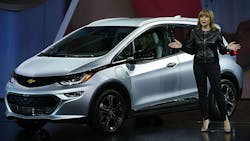CEO Barra: GM is 'Undervalued' and Can Sustain Profit Long Term
General Motors Co. CEO Mary Barra considers the largest U.S. automaker undervalued.
It’s easy to see why. After record profit last year and higher earnings in the first quarter, GM shares are down 12% this year. Slowing growth in U.S. auto sales and long-term threats from auto industry interlopers like ride-sharing firm Uber Technologies Inc. and self-driving car developer Google are among investors’ concerns.
Barra made the case in an interview with Bloomberg Television that GM can handle a downturn and sustain profits if the economy slumps in the next few years. The company also is making investments in ride sharing and self-driving cars to ensure its long-term future.
“I absolutely think, and we think, we’re undervalued right now,” Barra said ahead of GM’s annual meeting in Detroit. “We’re going to continue to work to keep making sure people understand exactly the mission of General Motors and what we’re working toward. I believe that as we continue to do that, that’s something that will take care of itself.”
Getting the stock price going is proving to be one of Barra’s most difficult challenges. Despite record profits, the shares have lingered below the $33 price from GM’s initial public offering in November 2010, closing at $29.99 on Monday.
GM can still break even in a U.S. market that sells 10 to 11 million vehicles, Barra said. Last year, automakers sold a record 17.47 million. Barra’s claim counters an estimate by Morgan Stanley analyst Adam Jonas, who said in a February report that GM and Ford Motor Co. need U.S. consumers to buy 13 million to 14 million vehicles to break even.
About 25% of GM’s workforce is made up of short-term workers who are “truly variable,” Chief Finance Officer Chuck Stevens said in an interview. GM would be able to cut work shifts quickly to slash costs if sales slowed, he said.
In May, GM’s U.S. sales plunged 18%, as the automaker shunned low-margin fleet deals with rental-car companies. For the second time this year, the company’s monthly market share dipped below 16%, according to researcher Autodata Corp. GM has been careful not to overbuild now, when sales are strong, so the company won’t have a glut of cars in inventory when the market slows down, Barra said. That would limit the need for big production cuts. The company is reducing about $5.5 billion in costs by 2018, she said.
Cruise, Lyft and the Driverless Future
As for the long-term threat to GM from the likes of Uber and Google, sales could fall if more consumers want to pay for cars as they use them, said Mark Reuss, GM’s executive vice president of global product development.
To counter this, GM has invested in Uber rival Lyft Inc. and bought Cruise Automation, an autonomous-drive technology company. The Cruise deal closed in May and GM already has Cruise’s autonomous software in the Chevrolet Bolt electric car, Reuss said.
Once GM has fully autonomous cars, its investment in Lyft can become compelling, President Dan Ammann said. Consumers hailing driverless Lyft cars would create a revenue stream with dwellers in congested cities who might not buy cars.
GM could still work with Google, which has tested self-driving cars over 1.4 million miles and is a shareholder in Uber, Reuss said. While Fiat Chrysler Automobiles NV plans to develop self-driving minivan prototypes that will be used by Google to test its self-driving technology, Google hasn’t ruled out more partners. “We’re absolutely open and willing to do that,” Reuss said of working with Google.
Other opportunities for growth include the GM Financial lending business, Stevens said. The lending arm finances about 30% of the automaker’s retail sales. That should grow to as much as 55% in the next few years, he said.
Ammann points to Cadillac. The global luxury business is 10% of sales and 30% of profits. Cadillac has a small piece of that. The luxury marque is growing in China but receding in the U.S. GM plans to spend $12 billion to develop eight new Cadillac models by 2020 and two more in the next decade.
“Our journey with Cadillac is going to be a multi, multi-year journey, and we’re completely committed,” Ammann said. “Too early to declare victory, at this stage.”
The same could be said for those selling GM stock.
By David Welch and David Westin
About the Author
Bloomberg
Licensed content from Bloomberg, copyright 2016.
